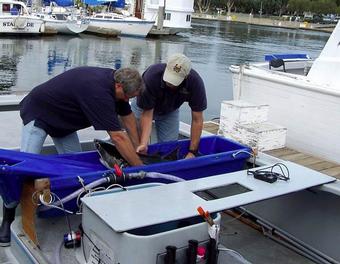Feb 24, 2005

The white shark may be shrouded in a school of shimmering uncertainties, but one thing is for certain: the female that's been patrolling the Monterey Bay Aquarium's Outer Bay exhibit for the last four months won't be here forever.
"It's inevitable that we'll have to release her," says the Aquarium's Rachel Gomez. "She's going to be too big for the tank sooner or later. We'll keep her as long as she's still feeding and successfully navigating the tank."
In the meantime, the white shark is one of the most observed creatures in the world. In addition to 24-hour video surveillance and a team of 15 to 20 people, led by senior biologists who evaluate her every day, the aquarium has enjoyed a 30 percent increase in visitors since the white shark arrived last November.
According to Gomez, they're expecting to see that number
jump this summer, when the high season for tourism kicks into
gear. "It will be our first full summer with the shark."
Predatory Ambassador
"It's common for conservation groups to draw people to their message with prominent mega-fauna," says John O'Sullivan, the Aquarium's curator of field operations. "The Aquarium didn't create the current hysteria for sharks, but if we can get people in and teach them about conservation, then I think we're really making a contribution."
This weekend, the Aquarium invites the public to "get up close and personal" with its favorite shark during Shark Days, an event that includes presentations, informal discussions with shark aquarists and behind-the-scene tours of the Outer Bay exhibit. Highlights include Surviving Sharks, a 20-minute film by Jaws author Peter Benchley, and sharky crafts for the whole family.
Yet more than anything else, Shark Days is a celebration of the white shark program and its world-famous prize. Weekend visitors will have the opportunity for personal interactions with staff like George Peterson, a diver who helps monitor and care for the white shark.
Peterson dives the Outer Bay exhibit about four times a month to observe the shark and do routine maintenance.
"We put on custom-made chain mail made for us to go diving with all kinds of animals," he says. "It's a passive protection system, safe not only for humans but the animals as well."
Despite the chain mail, Peterson doesn't believe the shark is dangerous.
"We've never observed any aggressive behavior at all towards her tank mates or the divers."
Of course, that may change. Since arriving to the Outer Bay exhibit, the white shark's been growing roughly four-and-a-half inches a month.
Every step of this project has been new territory, as this is the first white shark to survive more than three days in captivity.
"We're writing the manual on this as we go," Gomez says.
How To Catch a Shark
According to O'Sullivan, there are four primary reasons why the white shark program has succeeded where others have failed: the first two are the Monterey Bay Aquarium's generous funding and the expertise of the aquarium's resident veterinarian, Dr. Michael Murray; the other two are recently developed technological tools.
"Early tagging data showed us that the ocean temperatures and depths these juvenile sharks spent a lot of their time at were very similar to our tank," O'Sullivan says. "While the open-ocean holding pen allowed us to transition the animal in a place that relieved the initial capture stress."
Yet despite its undeniable success, the project has been controversial from the outset. Sean R. Van Sommeran, of the Santa Cruz-based Pelagic Shark Research Foundation, believes that the white shark should not be in captivity at all.
"It's a policy issue," Van Sommeran says. "Our policy is against the captive display of certain species. The Aquarium used to share that policy. We're simply concerned for the animal's welfare."
Van Sommeran says complications are bound to develop when the shark gets too big for the tank, but that the real danger lies is in her release.
"They're going to be releasing a couch potato," he says. "It's spent all its time in a relaxed swimming posture." Although evidence suggests the instinct to hunt is hardwired in white sharks, Van Sommeran says, "We just don't know how she's going to fare in the wild after captivity."
Shark Days runs this Saturday and Sunday from 10am to 6pm.Free with aquarium admission. Call 648-4888 or visit www.mbayaq.org for more info.
| THEWEEKLYTALLY | |
| 3,000 |
The maximum number of teeth in the jaws of a white
shark.
|
Printer Friendly Version



